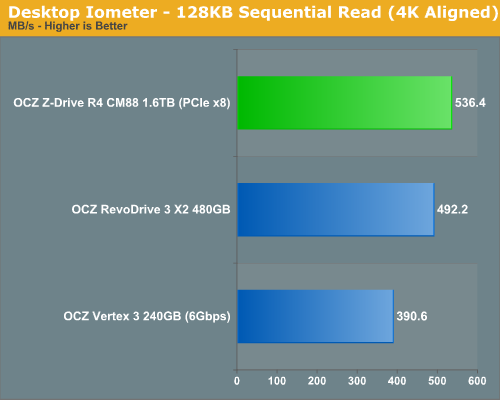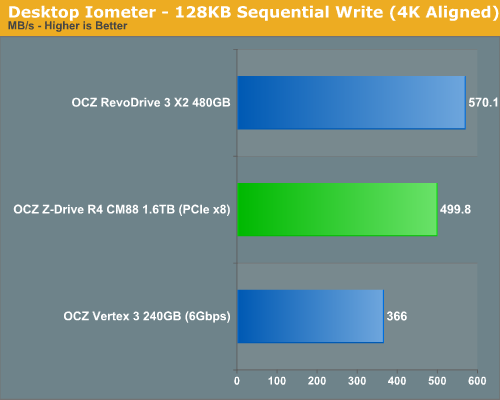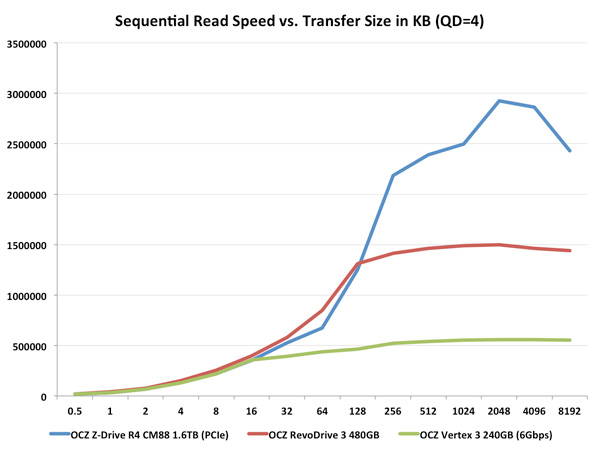OCZ Z-Drive R4 CM88 (1.6TB PCIe SSD) Review
by Anand Lal Shimpi on September 27, 2011 2:02 PM EST- Posted in
- Storage
- SSDs
- OCZ
- Z-Drive R4
- PCIe SSD
Sequential Read/Write Speed
To measure sequential performance I ran a 1 minute long 128KB sequential test over the entire span of the drive at a queue depth of 1. The results reported are in average MB/s over the entire test length. These results are going to be the best indicator of large file copy performance.


Again we see that low queue depth transfers don't stress the Z-Drive enough to flex its muscles.
Sequential Performance vs. Transfer Size (ATTO)
I stopped putting these charts in our reviews (although I do include the data in Bench) because they are generally difficult to read. Here we're only going to look at three drives though: a Vertex 3, RevoDrive 3 X2 and the Z-Drive R4 CM88:
Now we're starting to see something. If you can't scale with queue depth, scaling up the transfer size seems to do the trick. After about 64KB the Z-Drive R4 starts to pull away fro the RevoDrive 3 X2, peaking at just over 2.5GB/s!
Read performance is even more impressive: the Z-Drive R4 manages just under 3GB/s for 2MB transfer sizes.












57 Comments
View All Comments
lorribot - Wednesday, September 28, 2011 - link
You cant raid it in software but you could raid several of them if you have deep pockets.The point is why buy a 1.6 or 3.2 TB SSD when you can buy 10 x 320 gb SSDs and (possibly) get better performance for less cost?
bjacobson - Tuesday, September 27, 2011 - link
I think I've mentioned this before but can you load up a Windows 7 installation with 30 or so startup programs and compare the startup time difference between this and a harddrive?A video of this would be be even impressive.
ckryan - Tuesday, September 27, 2011 - link
I've been going through some issues with a 2281 drive with Toggle nand. I'm basically writing 11TB a day to it and under these conditions I can't get too many hours in between crashes. I'm of the opinion that the latest FW has helped most out, but clearly my experience shows that the 2281, when perfected, will be unstoppable in certain workloads, but for now all SF users are going to have some problems. If the problems are predictable you can compensate, but if they're random, well SF controllers aren't the only things that have problem with randomness. I knew it was a possibility, and that normal users won't abuse their drives as much, but I have to wonder if OCZ can make an enterprise drive problem free, why can't they make consumer SF drives better? The SF problem is the OCZ problem... OWC doesn't have the same perception issues, but is using the same hardware (Mushkin,Patriot, etc). As much as I like OCZ, they've done some questionable things in the past, and not just swapping cheap flash in SF1200 drives. Hopefully they can overcome the problems they're having with Sandforce and their Arrowana stuff, release a problem free next gen Indilinx controller, and then call it a day. Oh yeah, quit using those stupid plastic chassis.jalexoid - Tuesday, September 27, 2011 - link
Considering these devices are more likely to find themselves in a machine running something else than a desktop system, why not test them on another OS?sanguy - Wednesday, September 28, 2011 - link
OCZ's standard line "It's only affecting 0.01% of the deployed units and we're working on a fix....." doesn't work in the enterprise market.josephjpeters - Wednesday, September 28, 2011 - link
These are PCIe. Most of the "issues" come from SATA drives because mobo makers are having issues with their SATA ports.p05esto - Wednesday, September 28, 2011 - link
I'll admit, I'm now too lazy to even read....it's getting bad. I just want to push the "play" button while I sit back eating Cheetos and rubbing my tummy. Get into my tummy little Cheeto, get into my brain little ssd review,... same line of thinking really, whatever is easiest.Great review though, seriously.
alpha754293 - Wednesday, September 28, 2011 - link
If you want to really test it'and validate it's long term reliability, you pretty much need to do what enterprise customers do. Run the SSD, but always keep a backup of it somewhere, like you said.That being said though, if you've got TWO backup copies of it, you can actually run a parity check on it (pseudo-checksum) and determine its error rate.
Also, you didn't run HDTach on it. Given that it's tied together with a Marvell SAS controller, NOT being able to run TRIM on it, I would presume, will give it performance issues in the long run.
To do the error checking, you'll probably have to put this thing in a Solaris system running ZFS so you can mimic the CERN test. And if you actually read/write continuously to it, at the same level in terms of the sheer volume of data, other SSD/NAND-specific issues might start to pop up like wear levelling, etc. I would probably just run the read/write cycle for an entire month, where it periodically deletes some data, rewrite new data, etc. At the end of the month, make the two mirror backups of it. And then run it again. Hopefully you'd be able to end up at some identical endpoint after PBs of read/write ops that you can run both the block level and volume level checksum on.
But as a swap drive, this would be BLAZINGLY fast.
perrydoell - Wednesday, September 28, 2011 - link
You say "We have a preproduction board that has a number of stability & compatibility issues."This is the enterprise space. Things MUST WORK RELIABLY. How can you even review unstable products? I expect better from Anandtech.
I cannot take OCZ seriously either. An unstable product is NOT for the enterprise. Also, check the negative reviews at NewEgg. Ouch.
josephjpeters - Wednesday, September 28, 2011 - link
Where is the R4 listed on Newegg?